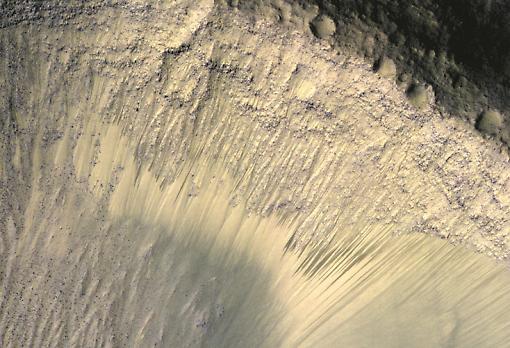
Mars is supposed to be a dead, dry planet. There are clear signs that liquid water used to flow across its surface – remember Nasa mocking up that video of the Mars of 3.7 billion years ago? – but one of the Curiosity rover’s jobs right now is to investigate what we take to be ancient river bed.
This makes it very surprising indeed that scientists saw dark, water-like streaks in the red dust, in 2011. This should not be happening on a planet with no atmosphere.
To be clear, this isn’t proof that there’s liquid water on Mars – it’s just that we’ve seen something that looks a heck of a lot like liquid water.
Those black lines, as spotted by the Mars Reconnaissance Orbiter, are known as “recurring slope lineae”, and they darken the Martian soil just as water darkens soil on Earth. They were originally found two years ago at seven sites in the highlands of southern Mars, at middle latitudes which warm up in the summer and freeze again in the winter.
This latest study, by the same team of planetary scientists led by Alfred McEwen of the University of Arizona in Tucson, has found a further 12 sites with streaks, all on or near the equator. The equator has roughly the same temperatures year-round, and that means that – if there’s liquid water flowing on the surface – there must be a mechanism in place to replenish it. Mars’ low atmospheric pressure means that liquid water on the surface should sublimate into a gas almost immediately.
We now know that there’s quite a lot of water on Mars, be it frozen on the surface at the poles, under the surface elsewhere on the planet, or bound up with the soil itself. The implication of a flowing water source is that it might be the most likely location of life that still exists on Mars – but, conversely, that also makes it more crucial that we don’t send improperly sterilised probes there. If those Earth microbes are to survive anywhere on Mars – and scientists recently discovered a whole new species of microbe that could survive in even the most sterile of spaceship construction labs – then they’ll survive on these slopes.
It’s also exciting for future colonists, who will save on energy if they don’t have to heat up ice for drinking water. Our best chance of figuring out the exact nature of these lines on Mars is from afar, with the Mars Reconnaissance Orbiter, until we can decide what further action to take. Perhaps even the first colonisers, whoever they be (maybe it’ll be Mars One, who want to send people there on a one-way mission starting from 2024) will be able to take advantage of that water source.
Originally posted 2013-12-16 22:47:37. Republished by Blog Post Promoter

![mars-water-proof[1]](https://coolinterestingnews.com/wp-content/uploads/2013/12/mars-water-proof1.jpg)










